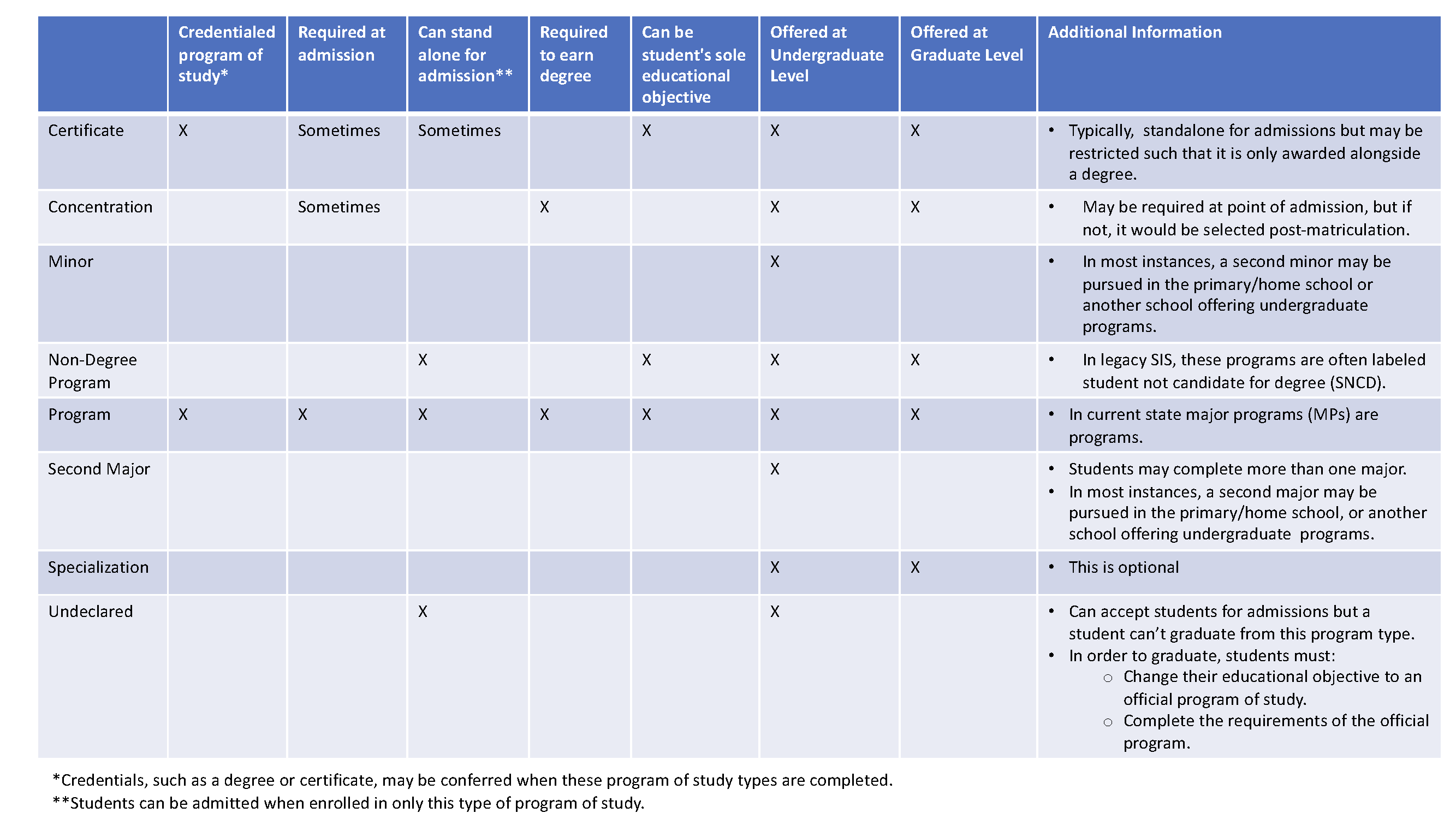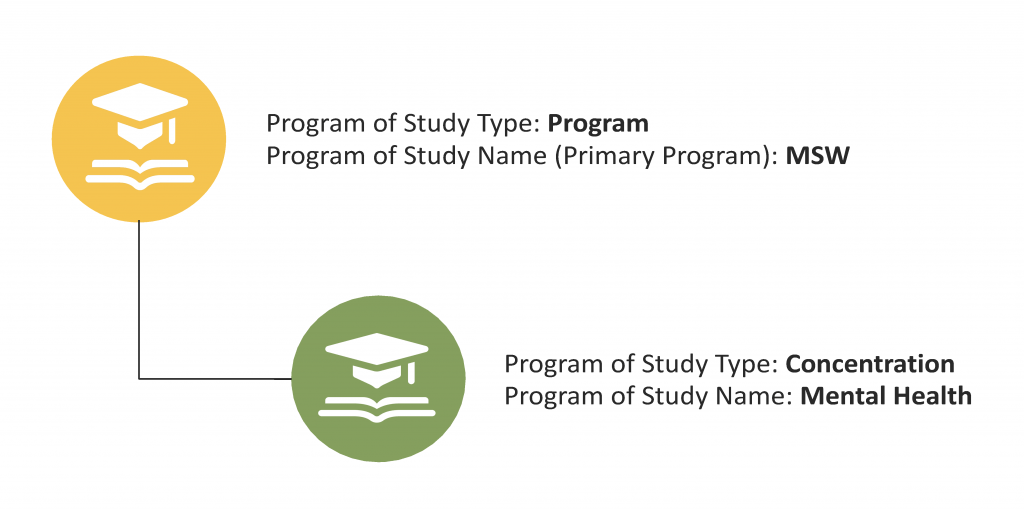Key Idea
Programs of study are used to organize academic functions (such as course requirements), people (such as faculty or students) and/or credentials (such as degrees or certificates) within Workday. Today’s major program (MP) in SIS is the analogue to a program of study in Workday.
Jump To: Program of study types | Primary programs | Relationships between programs | Programs of study & academic units | Academic divisions as programs of study | Programs of study & effective dating| Addable and stackable programs of study
Programs of study overview
Within Workday Student, programs of study are used to organize academic functions (such as course requirements), people (such as faculty or students) and/or credentials (such as a degree or certificate). Credentials may be conferred when a student completes a program of study. When a new program of study is created and students are admitted, the educational credential – or credentials awarded at completion – are placed on the student’s record with associated academic requirements.
Today’s major program (MP) in SIS is the analogue to a program of study in Workday. In Workday, majors, minors, second majors, certificates, non-degree programs, Master’s degrees, and PhD degrees are all considered programs of study. A student’s academic record(s) in Workday will track all programs of study a student has pursued or is currently pursuing at WashU.
Program of study types
Workday offers several categories and types of programs of study. Functionality is different in Workday for each program of study type. The table below outlines the different types.

*Please note: Programs that today are called joint programs or joint degrees will now be called dual programs or dual degrees.
Primary programs
Workday requires one program to be a student’s “primary” program. The primary program is by default the first active declared program the student is admitted into. The term “primary” is solely due to system configuration and will have reporting and policy implications. For students with only one major, their major is their primary program.
A program must be able to stand alone to be a primary program. Minors, second majors and some of the certificates that are not standalone cannot be a primary program.
Example of a primary program that can stand alone and is the student’s only major:
- Student’s primary program of study: Bachelor of Arts with a major in Chemistry
Example of a minor and second major that cannot stand alone:
- Student’s primary program of study: Bachelor of Arts with a major in Chemistry
- Student’s second major (has to be bundled with the primary): Second major in Biology
- Student’s minor (has to be bundled with the primary): Minor in English
Relationships between programs
Workday Student allows the creation of relationships between programs of study, and students will have clear visibility into which combinations are possible and how the programs interact. Some degree programs require a corresponding concentration, either at the point of admission or post-matriculation.
A second major, on the other hand, will be set up as a different program of study type that doesn’t accept students for admission and can’t be the student’s only educational objective but can be bundled with an official program.

Programs of study & academic units
A program of study is housed in one of the schools but may have a coordinating academic unit (AU) to support reporting and business process routing. For example, a major in chemistry may be housed by the Arts & Sciences AU, but the Chemistry AU could be the coordinating AU. For this example, as the coordinating AU, Chemistry could initiate a process to change the requirements for the major, and the request would route to Arts & Sciences as the main AU. This example is for illustrative purposes only.
Academic policies control the rules and process that students follow based on their primary program. These policies are inherited based on the academic unit that houses the student’s primary program of study.
Academic divisions as programs of study
Most academic divisions will translate to academic units, which are used in Workday to represent WashU’s schools or any other unit that admits students and offers programs of study or courses.
A few academic divisions are more appropriately categorized as a program of study in Workday because Workday has specific criteria for what should be an academic unit (AU), and some of our legacy academic divisions don’t meet those criteria. Programs of study organize course requirements and any associated credentials (e.g., degrees, certificates) for WashU’s various academic program offerings, including majors, minors, concentrations, etc.
Workday requires each student to have a “primary” program of study on each academic record. The primary program is by default the first active declared program into which a student is admitted. For students with only one major, their major is their primary program. Primary programs affect which policies (as configured in Workday) apply to a student. Primary programs also impact reporting, for instance, which programs of study appear in search results for some reports.
In Workday, students may have more than one academic record, which means they may also have more than one primary program of study, which is not possible today. As an example, a student who is starting their graduate program while wrapping up their undergraduate program would have two academic records.
Programs of study & effective dating
Programs of study, as with most concepts in Workday, have effective dates. When a new program is created, a first entry date is the earliest date a student can matriculate into the program. If academic requirements are adjusted for a given program, students will be required to meet the requirements as they were when the student matriculated into the program.
Similarly, the last entry date is the last date a student can matriculate into a program. This would be used if the program is being discontinued. The last entry date does not affect students enrolled in the program prior.
Effective dating may have an impact on the records and admissions processes. For example, when reporting on programs, it is imperative a user is aware of effective dates as the data viewed will be as of a certain date, like snapshot in time.
Addable and stackable programs of study
The ability for students and administrators to add a program to a student’s record is determined by the addable programs configured on the program of study set as “primary.”
- Addable programs of study must be completed at the same time as the primary program.
- For example, a student with a bachelor’s degree with a major in history would be able to add any minor or second major from Olin, Sam Fox or McKelvey or a minor or second major from Arts & Sciences except a minor or second major in history.
- Stackable programs of study do not have to be completed at the same time as the student’s primary program.
- All credentials on stackable programs are conferred.
- For example, an undergraduate certificate would be “stackable” so that a history major could earn a certificate (i.e., teaching certificate) separate from the bachelors.
Program of study FAQ
*Last update 04/06/23